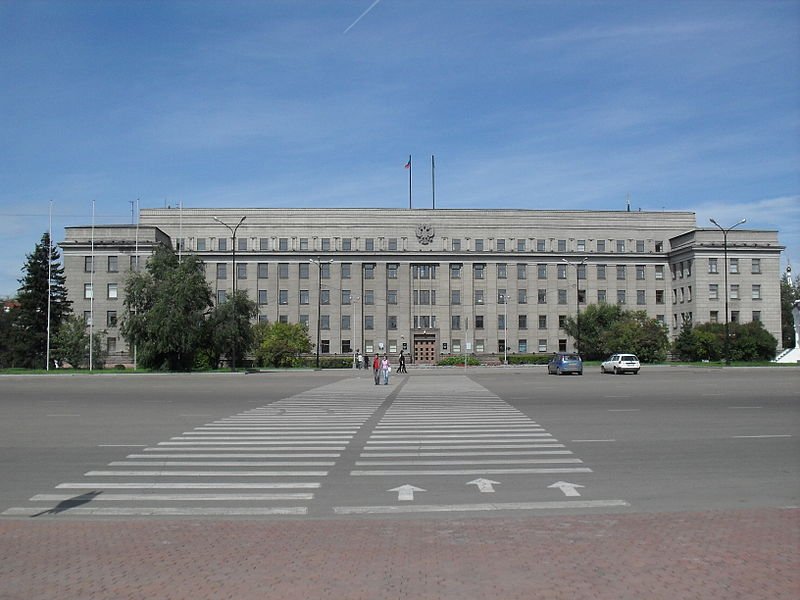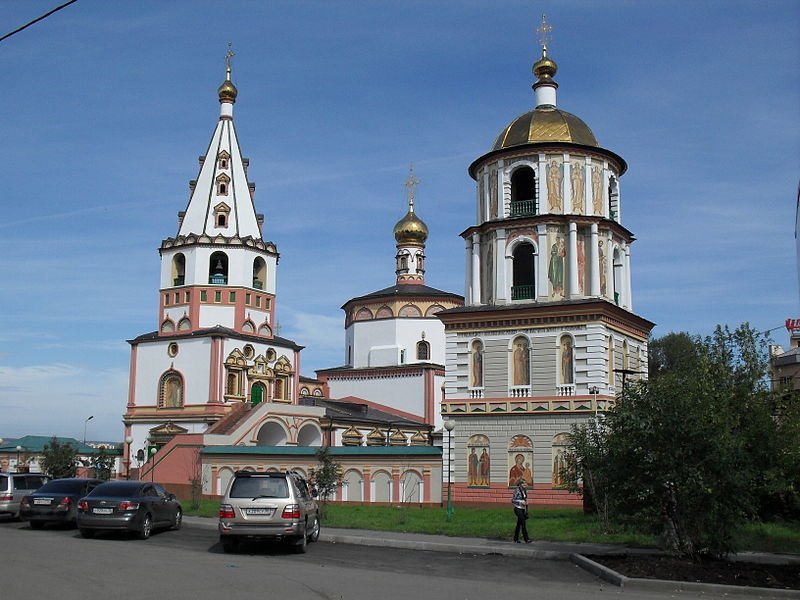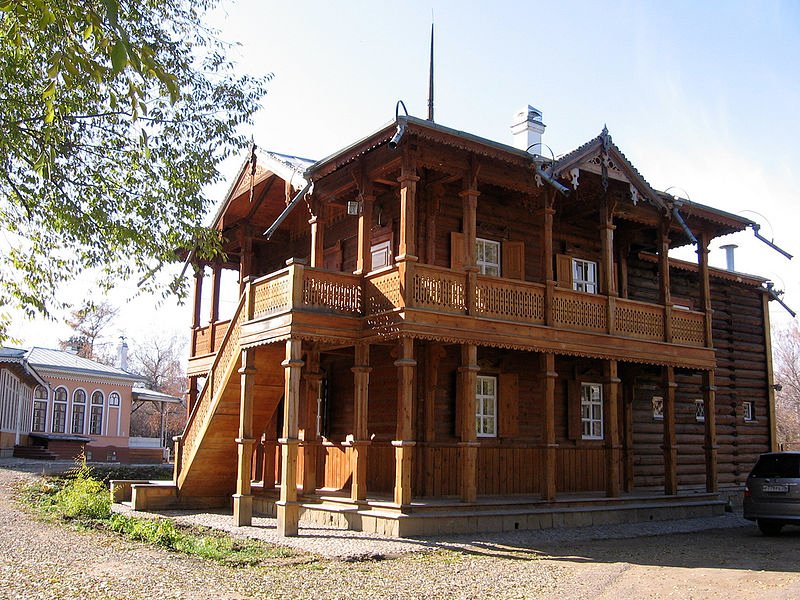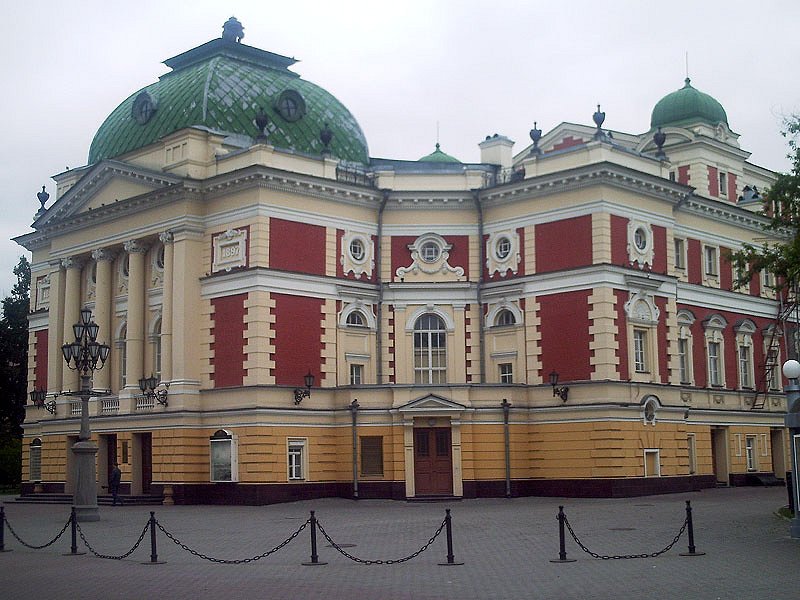 Grey House, a government building in Irkutsk, Russia
Grey House, a government building in Irkutsk, RussiaSource: https://commons.wikimedia.org/wiki/File:%D0%98%D1%80%D0%BA%D1%83%D1
%82%D1%81%D0%BA._%D0%97%D0%B4%D0%B0%D0%BD%D0%B8%D0%B5_%D0%BF%D1%80%D0%B0%D0%B2%D0%B8%D1%
82%D0%B5%D0%BB%D1%8C%D1%81%D1%82%D0%B2%D0%B0..JPG
Author: Fanzuga

Irkutsk (Russian: Ирку́тск, map) is the administrative capital of Irkutsk Oblast, and one of the largest cities in Siberia, Russia. It has a population of 590,000 (2011 estimate), down from 593,000 in 2002 and 622,000 in 1989. The city observes the Irkutsk Time (UTC+9).
Irkutsk is located on the banks of the Angara River, which emerges from Lake Baikal 72 km (45 mi) away, and flows into the Yenisei. The city itself was named after the smaller Irkut River which flows into the Angara directly opposite the city. The terrain in Irkutsk comprises rolling hills.
 Church of the Epiphany, Irkutsk
Church of the Epiphany, IrkutskSource: https://commons.wikimedia.org/wiki/File:%D0%98%D1%80%D0%BA%D1%83%D1%82%D1%81%D0%BA._%D0%91%D0%BE%D0%B3%D0%
BE%D1%8F%D0%B2%D0%BB%D0%B5%D0%BD%D1%81%D0%BA%D0%B8%D0%B9_%D1%81%D0%BE%D0%B1%D0%BE%D1%80_1.JPG
Author: Fanzuga

Irkutsk experiences a subarctic climate. Summers are moderately hot while winters are extremely cold. The warmest month is July, when the average high temperature rises to 24.6°C (76.3°F). For five months in a year, the average temperature in Irkutsk drops below 0°C. Coldest month is January, when the average low temperature dips to -25.1°C (-13.2°F). July receives by far the most rain of the year, at 120 mm (4.72 in).
Irkutsk was first settled in 1652. A few years later, a military installation was place there. This grew into a town in 1686. It remains a distant outpost until 1760, when the Siberian Road was built, linking it to Moscow and China. This enable goods to flow, mostly from China via Kyakhta, into Irkutsk and onwards to the rest of Russia.
 Traditional wooden house, Irkutsk
Traditional wooden house, IrkutskSource: https://commons.wikimedia.org/wiki/File:Wooden_architecture_in_Irkutsk_11_-_seseg_h.jpg
Author: seseg_h

In the early 19th century, Irkutsk became the destination of Russian artists and nobles banished by Tsar Nicolas I for the Decembrist revolt (of 14 December 1825). By the end of the 19th century, one in every three persons in Irkutsk was an exile. They enriched Irkutsk with intellectual and social life, and the city's cultural heritage is the result of their influence.
During the 20th century, the Soviet greatly industrialized Irkutsk, building among them the Irkutsk Reservoir and military installations. Today the largest industry in the city is aviation, particularly the manufacture of military aircrafts.
 Okhlopkhov Theater, Irkutsk
Okhlopkhov Theater, IrkutskSource: https://commons.wikimedia.org/wiki/File:Okhlopkhov%27s_theatre_01.jpg
Author: Egor Kurlyuk

Visiting Irkutsk
Irkutsk Airport (IKT) receives flights from Moscow, St Petersburg, Beijing, Ulaanbaatar, Shenyang, Bangkok and Phuket, among others. If you are flying in, it is best that you arrange the transport to fetch you before arriving, as you may have difficulties finding a taxi driver that speaks English. There are however other forms of public transport such as buses and trams linking the airport with the city, which is about half an hour away.Sights & Attractions in Irkutsk
- Angara Dam
A massive dam on the Angara River. - Bogoyavlensky Cathedral
An attractive church in salmon pink with white and green towers, located on the riverfront. - Kazansky Church
Brightly painted church with salmon-pink walls and turquoise domes and gold crosses. - Preobrazheniya Gospodnya Church
A beautiful church in pink. - Raising of the Cross Church
Church built in 1758. It has an ornate interior with gilt-edged icons. - Regional Museum
Museum in the 1870 brick building formerly occupied by the Siberian Geographical Society, today displays items associated with the history of the region. - Saviour's Church
A church that was once used as a museum. It still bears the brunt of Communist wounds. - Statue of Tsar Alexander III
Statue put up in the post-communist era. It stands at the riverfront promenade. - Trinity Church
Church first built in the 18th century and now undergoing restoration. - Trubetskoy House-Museum
Museum of former Decembrist exile Trubetskoy. It is smaller than the Volkonsky House-Museum. - Volkonsky House-Museum
Museum housed in the former residence of Decembrist exile Court Sergei Volkonsky. It provides a glimpse into the still lavish lifestyle of those banished to Irkutsk. - Znamensky Monastery
Monastery built in 1762. It has an interior with murals on its vaults. A gold sarcophagus in the monastery holds sacred relics of St Inokent.
 Latest updates on Penang Travel Tips
Latest updates on Penang Travel Tips
 Discover with Timothy YouTube Channel
Discover with Timothy YouTube Channel
 PG Food Channel
PG Food Channel
 Learn Penang Hokkien YouTube Channel
Learn Penang Hokkien YouTube Channel
 SojiMart Videos
SojiMart Videos
Latest from Discover with Timothy: Gurney Bay - what to see and do there
About this website

Hello and thanks for reading this page. My name is Timothy and my hobby is in describing places so that I can share the information with the general public. My website has become the go to site for a lot of people including students, teachers, journalists, etc. whenever they seek information on places, particularly those in Malaysia and Singapore. I have been doing this since 5 January 2003, for over twenty years already. You can read about me at Discover Timothy. By now I have compiled information on thousands of places, mostly in Peninsular Malaysia and Singapore, and I continue to add more almost every day. My goal is to describe every street in every town in Malaysia and Singapore.
Robbie's Roadmap
- Episode 1: Robbie's Journey to Financial Freedom
- Episode 2: Lost in America
- Episode 3: The Value of Money
- Episode 4: The Mentor
- Episode 5: The Thing that Makes Money
- Episode 6: The walk with a Billionaire
- Episode 7: The Financial Freedom Awakening
- Episode 8: Meet Mr Washington
- Episode 9: The Pizzeria Incident
Copyright © 2003-2024 Timothy Tye. All Rights Reserved.


 Go Back
Go Back